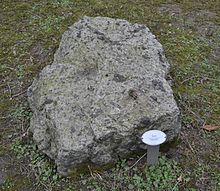Nördlinger Ries
You can help expand this article with text translated from the corresponding article in German. (December 2021) Click [show] for important translation instructions.
|
| Nördlinger Ries | |
|---|---|
 Relief map of Nördlinger Ries | |
| Impact crater/structure | |
| Confidence | Confirmed |
| Diameter | 24 km (15 mi) |
| Age | 14.808 ± 0.038 Ma, Middle Miocene |
| Exposed | Yes |
| Drilled | Yes |
| Bolide type | Achondrite |
| Location | |
| Coordinates | 48°53′N 10°34′E / 48.883°N 10.567°E |
| Country | Germany |
| State | Bavaria and Baden-Württemberg |
| District | Donau-Ries |
| Municipality | Nördlingen |
The Nördlinger Ries is an impact crater[1] and large circular depression in western Bavaria and eastern Baden-Württemberg. It is located north of the Danube in the district of Donau-Ries. The city of Nördlingen is located within the depression, about 6 kilometres (3.7 mi) south-west of its centre.
Etymology
"Ries" is derived from
Description


The depression is a meteorite impact crater formed 14.808 ± 0.038 million years ago in the Miocene.[4][5] The crater is most commonly referred to simply as Ries crater or the Ries. The original crater rim had an estimated diameter of 24 km (15 mi). The present floor of the depression is about 100 to 150 m (330 to 490 ft) below the eroded remains of the rim.
It was originally assumed that the Ries was of
The Ries impact crater was a rampart crater, thus far a unique finding on Earth.[11] Rampart craters have almost exclusively been found on Mars. Rampart craters exhibit a fluidized ejecta flow after impact of the meteorite, most simply compared to a bullet fired into mud, with the ejecta resembling a mudflow.
Another impact crater, the much smaller (3.8 km (2.4 mi) diameter) Steinheim crater,[12] is located about 42 km (26 mi) west-southwest from the center of Ries. It had previously been thought that the two craters formed simultaneously by the impact of a binary asteroid 14.8 million years ago, but a study published in 2020 suggests that Steinheim could actually be about 500,000 years younger than Nördlinger Ries.[13]
Recent computer modeling of the impact event indicates that the impactors probably had diameters of about 1.5 km (4,900 ft) (Ries) and 150 m (490 ft) (Steinheim), had a pre-impact separation of some tens of kilometers, and impacted the target area at an angle around 30 to 50 degrees from the surface in a west-southwest to east-northeast direction. The impact velocity is thought to have been about 20 km/s (72,000 km/h; 45,000 mph). The resulting explosion had the power of 1.8 million
.The Ries crater impact event is believed to be the source of
Stone buildings in Nördlingen contain millions of tiny diamonds, all less than 0.2 mm (0.008 in) across. The impact that caused the Nördlinger Ries crater created an estimated 72,000 tonnes (72,000,000 kg) of them when it impacted a local graphite deposit. Stone from this area was quarried and used to build the local buildings.[16]
Archaeology
On one edge of the Nördlinger Ries are the Ofnet Caves, where, at the beginning of the 20th century, archaeologists discovered thirty-three human skulls dating to the Mesolithic period.[17]
Astronaut training
The landing site for
References
- ^ J. Baier: Geohistorische Bemerkungen zur Suevit-Forschung (Ries-Impakt). Geohistorische Blätter, 31(1/2), Berlin 2020.
- ^ "37 Ries" (PDF). Entwurf einer kulturlandschaftlichen Gliederung Bayerns als Beitrag zur Biodiversität. Bayerisches Landesamt für Umwelt. 2011. Archived from the original (PDF) on 2018-12-12.
- JSTOR 2918785.
- .
- S2CID 214304156.
- ^ .
- ^ ISBN 9781101133224.
- ISBN 978-3-86544-162-1.
- ISBN 978-3-86544-172-0.
- ^ Baier, Johannes (2012). "Die Bedeutung von Wasser während der Suevit-Bildung (Ries-Impakt, Deutschland". Jber. Mitt. Oberrhein. Geol. Ver. (in German). 94: 55–69.
- doi:10.1130/G33934.1.
- ^ Baier, Johannes; Scherzinger, Armin (2010). "Der neue Geologische Lehrpfad im Steinheimer Impakt-Krater". Jber. Mitt. Oberrhein. Geol. Ver (in German). 92: 9–24.
- PMID 33335157.
- S2CID 11282087.
- PMID 33811229.
- ISBN 0-19-850341-5.
- ISBN 978-0521347945.
- ISBN 978-3-319-65177-4.
- ^ Phinney, William (2015). Science Training History of the Apollo Astronauts. NASA SP-2015-626. p. 237.



